Experience the Thrill of Snow Kiting in Norway
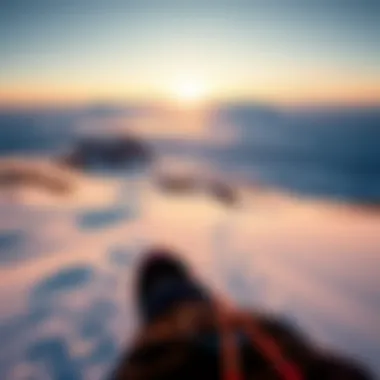
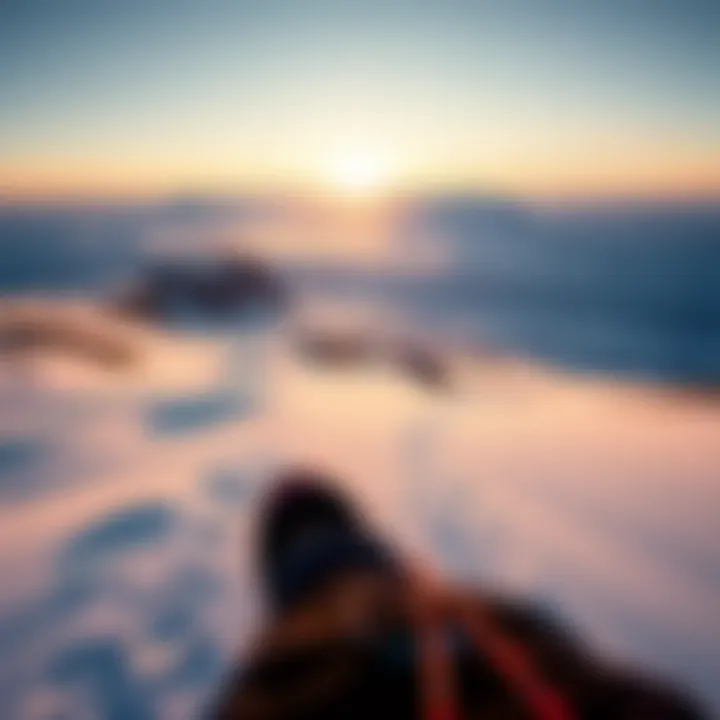
Intro
Snow kiting is more than just a sport; it’s a captivating blend of adventure and communion with nature. In the vast white expanses of Norway, where the skies often dance with the shimmer of sunlight glistening on snow, this activity unfolds like a chapter from a thrilling novel. Enthusiasts from all walks of life gather here, drawn in not only by the excitement but also by a unique landscape that features rolling hills, frozen lakes, and majestic mountains. The harmony of wind and snow creates opportunities for both novices and seasoned veterans alike.
You'll find that snow kiting is not just about whisking across the snow-covered terrains but also about understanding the vital elements that can elevate the experience. Essential gear, the right tactics, and knowledge of safety protocols form the bedrock of any successful outing. Whether you are a die-hard adventurer or just dipping your toes into this exhilarating activity, Norway offers a plethora of conditions conducive to your snow kiting passion.
Let’s embark on this journey together and dissect the crucial aspects that make snow kiting an engaging pursuit. From selecting the right gear to mastering essential techniques, this guide aims to equip you with the insights needed to thrive in this thrilling pursuit.
Gear Selection
When it comes to snow kiting, selecting the appropriate gear is paramount. Getting well-equipped not only enhances your performance but also ensures your safety throughout your adventure.
Types of Kites
The first piece of equipment to consider is the kite itself. In Norway's varying wind conditions, several types are in play. These include:
- Foil Kites: Lightweight and excellent for light wind, foil kites are perfect for beginners looking to get a feel for the sport.
- Leading Edge Inflatable Kites (LEI): Sturdy and versatile, LEIs are popular among experienced riders because they handle stronger winds with ease.
- Closed-cell Kites: These kites allow for superb performance in both snow and water, making them a favorite for those who enjoy multi-discipline activities.
Each type has its quirks and advantages, so it’s wise to consider your skill level and the typical wind conditions of your chosen snow kiting spot.
Choosing the Right Board
The next crucial piece of gear is your board. Picking the right one can dramatically influence your experience. Some factors to keep in mind:
- Board Size: A larger board provides greater stability and floatation, making it easier for beginners while smaller boards allow for better maneuverability for experienced kiters.
- Material: Look for durable yet lightweight materials that can withstand the rigors of snowy terrains.
- Bindings: Comfortable bindings are key; make sure they are snug yet allow for freedom of movement.
Investing in quality gear tailored for your needs can make the difference between frustration and pure joy on the snow.
Remember: Your confidence will grow as you become more comfortable with your gear. Local shops in Norway often offer rentals and demos, which can help you find the perfect match.
With your gear sorted, you're already halfway there. Now comes the fun part—transforming that equipment into firsthand experience through the right techniques.
Skill Development
Snow kiting, while thrilling, comes with a learning curve. Mastering essential techniques can make your experience more enjoyable and safe.
Essential Techniques
When it comes to snow kiting, having a few techniques under your belt can make a world of difference:
- Body Positioning: Keep your weight centered over the board. Lean back slightly to maintain balance without losing speed.
- Turning: To execute smooth turns, learn to control your kite's position in the wind. Keep your movements fluid and make small adjustments.
- Speed Control: Understanding how to adjust your kite's angle concerning the wind will enable you to control your speed effectively.
Progression Tips
As you begin to find your footing, consider these tips to help you level up:
- Practice in Varying Conditions: Facing diverse terrains and wind conditions will sharpen your reflexes and adaptability.
- Join a Community: Engaging with local snow kiters can provide insights that no manual can offer. The camaraderie found in these communities often leads to rich learning experiences.
- Attend Workshops: Formal lessons can accelerate your learning process and instill confidence.
Keep pushing your limits as you gain experience in snow kiting. Remember to take it one step at a time, as the thrill should never overshadow your safety.
An Overview of Snow Kiting
Snow kiting has carved out a unique niche in the world of adventure sports, especially in the breathtaking landscapes of Norway. This section aims to paint a vivid picture of what snow kiting is, offering insights into its origins and the allure it holds for those hungry for adventure and connection with nature.
Definition and History
At its core, snow kiting is the art of traveling across snow-covered terrain—be it on skis, a snowboard, or even a sled—while harnessing the power of the wind. Picture this: a kite catches the breeze overhead, and you glide across the snow, propelled not by muscle alone but by nature's own force. The practice of snow kiting isn’t a mere accident of design; it has roots that stretch back to traditional kiting practices and the evolution of board sports.
Records show that kites were used by various cultures for centuries, primarily in Asia, and as technology advanced, these ideas were adapted for use on snow. While snow kiting as we know it today began gaining traction in the late 20th century, it was around the early 2000s that the sport truly began to surge in popularity, particularly in countries with abundant snowy terrain like Norway. Pioneers in this field were able to translate the principles of wind power, honed for kitesurfing, into the frosty landscapes.
By using two types of kites—traction kites for speed and light wind conditions, and power kites in harsher elements—snow kiters can navigate the unpredictable aspects of snow and wind. This adaptability showcases the sport's broad appeal, making it accessible for newbies while offering challenges for the more seasoned practitioners.
The Attraction of Snow Kiting
What makes snow kiting a captivating venture? It's more than just the thrill of skiing or snowboarding augmented by wind power. The scenery plays a central role. Imagine yourself racing across frozen lakes or up secluded mountain slopes, surrounded by the stunning Norwegian vistas. Here are a few compelling elements that draw enthusiasts:
- Freedom of Movement: The open fields and hills offer a sense of liberation, where the only limitation is the kite's capacity.
- Connection with Nature: The sport fosters a deeper relationship with the environment, promoting awareness and appreciation for nature's beauty.
- Community Aspect: Events and meetups bring kiters together, creating a vibrant community where they can share tips, techniques, and camaraderie.
- Health Benefits: Alongside the excitement comes a great workout. Balancing, steering, and navigating the snow makes for an engaging physical endeavor.
"Snow kiting is both a dance with nature and a race against the wind, and it teaches invaluable lessons in patience and adaptability."
As more people discover this sport, its appeal transcends mere thrill-seeking. It's an invitation to explore the winter landscapes in a way that emphasizes coexistence with the natural world. With every ride, enthusiasts contribute to a culture that values skill, respect for nature, and a spirit of adventure.
The Norwegian Landscape
The distinctive Norwegian landscape is not just a backdrop for snow kiting; it plays a pivotal role in the allure and experience of this exhilarating sport. With a unique melding of vast mountain ranges, sweeping valleys, and pristine coastline, Norway presents an array of terrains that appeal to kiteboarders of all skill levels. Moreover, understanding the geography and climate is crucial for anyone seeking to navigate the world of snow kiting effectively.
Geography and Climate
Norway's geography is a tapestry of contrasts. From the rugged peaks of the northern regions to the gentle slopes found further south, each area boasts its own charm. The country benefits from a subarctic climate in the north, marked by long, snowy winters—perfect for snow kiting. In contrast, the southern regions experience a milder climate but still provide excellent conditions, particularly in the winter months.


Wind conditions can also vary greatly depending on geographic location. Coastal areas often experience stronger winds, making them more suitable for experienced kiteboarders, while sheltered valleys might be ideal for beginners trying to master their skills.
It's important for kiteboarders to familiarize themselves with the local wind patterns and temperature fluctuations, as these can significantly affect performance and safety while snow kiting.
Ideal Locations for Snow Kiting
When it comes to identifying the best spots for snow kiting, Norway does not disappoint. With many picturesque and exciting locations, each area offers its unique characteristics that cater to various preferences.
Finnmark
Finnmark is known for its expansive, open terrain and stunningly beautiful landscapes. As Norway's northeasternmost county, it provides vast areas of untouched snow, which is ideal for snow kiting. One of the critical features of Finnmark is its consistent wind patterns, influenced by its proximity to the Barents Sea.
Benefits of snow kiting in Finnmark:
- Strong and steady winds throughout the winter
- Vast open spaces, reducing the risk of collision with obstacles
- Breathtaking views of the North Cape in the distance, creating a picturesque setting for adventurers
However, it is essential to note that the extreme northeastern climate can also lead to sudden weather changes, which presents both a thrilling challenge and a safety consideration.
Telemark
Telemark holds a special place in the hearts of many kiteboarders thanks to its beautiful rolling hills and picturesque valleys. The unique topography offers both beginner-friendly slopes and more challenging terrains for the experienced riders. Besides its natural beauty, Telemark is steeped in history, having been pivotal in Norway’s resistance during World War II.
Key characteristics of Telemark:
- An inviting mix of moderate slopes and steep hills, allowing for a range of skill levels.
- Numerous snow-covered areas make it an excellent choice for those who appreciate scenic kiting experiences.
However, the terrain's varied nature may result in unstable wind conditions, which could affect visibility and overall safety.
Sogn og Fjordane
Sogn og Fjordane is famed for its spectacular fjords and mountain scenery, creating a striking backdrop for any snow kiting adventure. The region’s numerous arms of the fjord can generate unique wind conditions, making it a suitable option for those seeking diverse challenges.
Unique features of Sogn og Fjordane:
- The stunning visual contrasts of deep blue waters against white snow create a mesmerizing environment.
- Areas with variable topographies offer unique wind currents that can enhance kiting adventures.
Nonetheless, the beauty of Sogn og Fjordane comes with its own set of challenges; the fjords' proximity to the ocean can make the weather unpredictable, requiring kiteboarders to stay vigilant and prepared for sudden changes.
"Understanding the landscape isn't just important; it's vital for safety and enjoyment. The Norwegian terrain offers opportunities, but also requires respect and awareness from its adventurers."
Essential Gear for Snow Kiting
When it comes to snow kiting, gear can make all the difference between a thrilling experience and a frustrating one. The right equipment not only enhances performance but also elevates safety and comfort during those windy adventures in Norway's dazzling landscapes. This section sheds light on the essential gear, emphasizing what every snow kiter should consider before hitting the snowy expanses.
Kites: Types and Sizes
The heart of snow kiting lies in the kite itself. Various types of kites cater to different rider styles and conditions. Generally, you’ve got two main types: foils and leading-edge inflatables (LEI).
- Foil kites are lightweight and pack down easily, making them a good option for backcountry touring. They are constructed from fabric cells, which fill with air as they fly. They’re great for stable, constant wind but can be less effective in highly variable conditions.
- Leading-edge inflatables provide greater wind range. These kites have air-filled tubes along the leading edge, making them easier to relaunch from the snow. They can handle a wider variety of wind conditions and are generally more forgiving for beginners.
Size matters too. Kites are usually measured in square meters; a larger kite will generate more power, which is perfect for lighter winds. However, in gusty conditions, smaller kites can offer better control. Finding the right size for specific wind conditions and rider weight is crucial for your performance and enjoyment.
Snowboards and Skis
While kites facilitate movement, the right snowboard or skis anchor that experience. Both options can be tailored for different styles of riding. If you’re skiing, a wider ski can give you more float on top of soft snow, while snowboarders might prefer a longer board to navigate effectively.
A board designed specifically for snow kiting will often feature a stiffer flex, making it easier to handle and control in changeable wind conditions. Keep in mind that your gear should not only suit your level but also the terrain you'll be tackling.
Safety Equipment
Safety shouldn't be an afterthought; it's paramount in snow kiting. Here’s a closer look at the vital pieces of safety gear that every snow kiter should consider:
Helmets
Helmets are your first line of defense. They protect your head from potential impacts during falls or accidents. Look for helmets specifically designed for winter sports, as they often include features like insulation to keep your head warm.
A key characteristic of a good helmet is its fit and ventilation. A snug fit ensures your helmet stays on during twists and turns, while adequate ventilation prevents you from overheating. Brands like Giro and Smith offer models that balance protection with comfort, making them popular choices among kiting enthusiasts. However, remember that while a helmet can save your noggin, it won’t necessarily protect against all types of injury.
Impact Vests
An impact vest is another essential piece. It provides cushion during falls, reducing the risk of injury to your torso. These vests often have padding along the back and sides but are lightweight, allowing for freedom of movement.
The unique feature of impact vests is their design; they often come with built-in flotation, which can be beneficial if you fall into the water or slushy snow. However, it’s worth noting that while they enhance safety, they might not provide as much warmth as specialized winter wear, so layering is key.
GPS Devices
Equipping yourself with a GPS device can enhance the overall experience of snow kiting, allowing you to keep track of your location and routes. This can be invaluable, especially in Norway’s vast snow-covered landscapes where visibility may suddenly decrease.
The standout aspect of GPS devices for kiting is their ability to monitor speed and altitude, which can be exciting for those looking to push their limits. They can also come with safety monitoring systems, enabling you to notify others if you encounter issues. However, keep in mind that reliance on technology means understanding how to effectively use these devices, which can vary in user-friendliness.
Equip yourself wisely. The right gear not only boosts performance but ensures safety in unpredictable conditions.
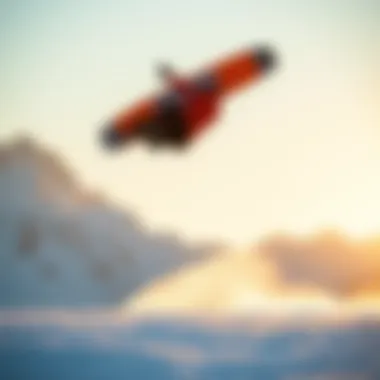
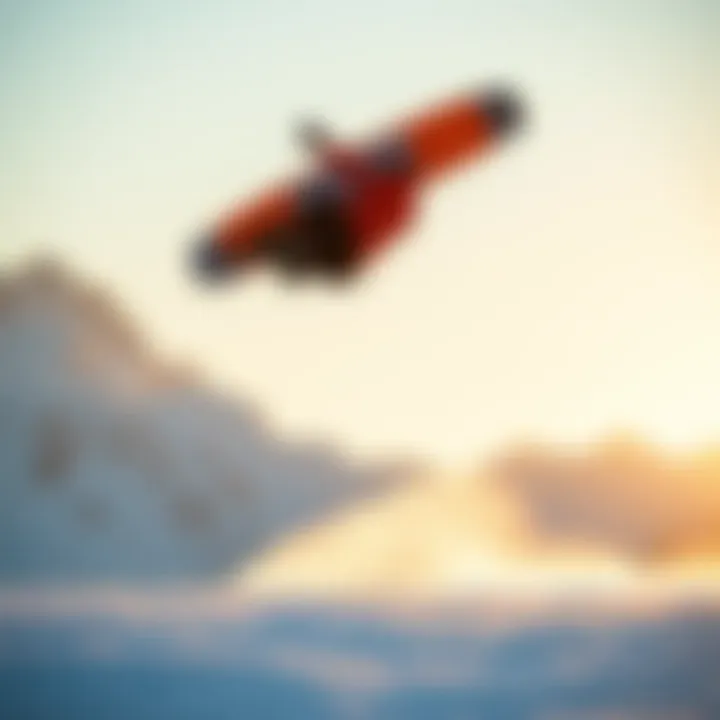
In sum, the essential gear for snow kiting goes beyond style; it’s about creating a safe, enjoyable environment for this exhilarating sport.
Techniques and Skills
In the thrilling world of snow kiting, mastering techniques and skills is crucial for both safety and enjoyment. Whether you are just starting out or looking to take your skills to the next level, understanding the various aspects of snow kiting can greatly enhance your experience. It isn't merely about harnessing the power of the wind; it's about communicating with it, negotiating the landscape, and developing a rhythm with the elements around you. The right techniques not only increase your control but also add to the fun and challenge of the sport.
Getting Started: Basics for Beginners
For newcomers, the learning curve can feel steep. However, starting with the basics lays a solid foundation for more advanced skills later on. First, familiarize yourself with your equipment, specifically your kite and board. Basic maneuvers include how to launch and land the kite properly, how to steer and maintain balance on your board, and understanding how to adjust your body position in relation to the wind.
A good initial exercise is practicing with smaller kites. They are generally easier to control and allow beginners to feel more confident. Another vital aspect is learning to read the wind; being aware of its patterns helps in predicting changes, which might affect your ride.
When starting out, joining a local class with an experienced instructor can be invaluable. They provide tips and tricks that save time and help prevent mistakes that could lead to frustration or accidents.
Advanced Techniques
As riders become more confident, they often want to tackle more advanced techniques that can elevate their snow kiting experience.
Jumping
Jumping is perhaps one of the most exhilarating aspects of snow kiting. The thrill of launching into the air and feeling the rush of freedom often draws many people to the sport. The key characteristic of jumping involves the proper timing and technique. Riders must learn how to edge their board and simultaneously pull on the kite at the right moment.
A unique feature of jumping is the ability to tailor the height and distance by adjusting the angle of the kite. This opens up opportunities for creativity, allowing each rider's style to shine through. However, one should be wary of the landing, as improper technique could result in injuries. Thus, practice on softer terrain is recommended until the technique is mastered.
Turning
Turning is a critical skill to develop and is often more nuanced than it seems. The ability to turn effectively not only allows for greater control over trajectory but also enhances the ability to navigate obstacles and changes in the terrain. The unique feature of turning involves shifting your weight while maintaining a steady pull from the kite. This might seem simple, yet the subtleties in movement can make a world of difference.
Due to the nature of snow kiting, where the landscape can be unpredictable, mastering turning becomes a fundamental part of riding efficiently and safely. A well-executed turn can prevent unnecessary falls and bump into obstacles, making it a highly beneficial skill.
Handling Different Wind Conditions
One of the challenges of snow kiting is managing various wind conditions, which can change on a dime, especially in Norway's diverse landscapes. Learning the specifics about how to handle different wind conditions is paramount for safety and performance. This involves understanding how to adjust the kite’s position and speed according to the wind's strength and direction.
What's notable about this skill is its adaptability; the better you can handle different wind conditions, the more versatility you gain in your riding. If conditions change quickly, a rider who can read the wind and adapt immediately can avoid dangerous situations and enjoy their session more.
Practicing in controlled environments with variable wind conditions can help develop this skill. It’s about getting comfortable with the unpredictable nature of the sport and embracing the challenge that each change in wind presents.
"The essence of snow kiting lies not just in the thrill, but in learning to dance with the wind."
As you venture deeper into snow kiting, refining your techniques and skills becomes a rewarding journey that enhances your overall experience.
Safety Protocols
When it comes to adventure sports, the thrill is often accompanied by a certain level of risk. Snow kiting in Norway is no exception. Establishing robust safety protocols is essential to ensure the well-being of all who participate in this exhilarating sport. By understanding the essential elements of safety in snow kiting, enthusiasts can enjoy the experience while minimizing potential hazards.
Understanding Wind Patterns
Wind is the lifeblood of snow kiting. Any kiteboarder worth their salt knows that understanding wind patterns can be the difference between an exhilarating ride and a dangerous situation. Wind can change quickly and unexpectedly, particularly in Norway's varied terrain. An inexperienced kiter may be tempted to ignore signs, but experienced riders pay close attention to factors such as:
- Wind speed: Knowing the maximum wind speed that you can handle is crucial. What's exhilarating at one moment could turn perilous in the next.
- Wind direction: Different terrains can result in unexpected shifts in wind direction. Understanding how local topography affects wind flow is vital.
- Wind gusts: These sudden changes can catch you off guard. Look for visual clues, like moving trees or ripples on the snow.
In case the wind picks up more than anticipated, having a strategy is key. Familiarize yourself with how to adjust your kite and position yourself accordingly to safely land or maneuver back to less windy zones.
"The power of the wind should not be underestimated; it can be your best friend or your worst enemy."
Weather Considerations
Weather plays a significant role in snow kiting. In the unpredictable Norwegian climate, knowing before you go is imperative. Weather forecasts are not just suggestions but should be considered a vital part of your pre-kiting checklist. Consider the following points:
- Temperature swings: Norway can experience drastic temperature changes, and cold weather can lead to ice formation and hazards beneath the snow surface.
- Visibility: Low visibility due to snowstorms or fog can be dangerous. If you can’t see, you can't navigate safely.
- Avalanche risks: In certain areas, the risk of avalanches is real. Understanding the snowpack and following local guidelines can save your life.
Before heading out, it’s wise to check resources such as Yr.no for accurate weather updates tailored for specific locations in Norway.
Emergency Procedures
Even with the best safety measures in place, emergencies can occur. Being prepared can make all the difference between a close call and a disaster. Riders should have a plan, which includes:
- Familiarity with emergency signals: Learning and using signals for help—whether it’s a whistle or hand gesture—could alert nearby kiters if you’re in distress.
- First-aid knowledge: Having a basic first-aid kit is essential, but knowing how to use it is key. Knowledge of CPR or other first-aid skills could be crucial.
- Communication: Ensure you have a means of communication, whether it’s a mobile phone or radio, that works in snowy, cold environments. Establish a check-in plan with your group before venturing out.
Cultural Significance of Snow Kiting in Norway
Snow kiting in Norway embodies more than just a thrilling adventure sport; it serves as a significant cultural activity that weaves together community, nature, and tradition. It connects participants not only with the stunning landscapes of Norway, but also with each other, fortifying bonds among kiteboarders and outdoor enthusiasts. The sport reflects the rich heritage of Norwegian outdoor life, showcasing how locals have long embraced the elements as part of their way of living.
Community and Events
Norwegian snow kiting is synonymous with community spirit. Local clubs often organize events that draw in participants from different regions, fostering a strong sense of fellowship. Events such as the Norwegian Snowkite Championship showcase the skill and passion of riders, while also encouraging newcomers to take part and learn. These gatherings are more than competitions; they are social occasions that promote shared experiences.
Kiteboarding groups on platforms like Facebook have sprouted, allowing kiteboarders to share tips, gear recommendations, and their personal stories. Online forums such as Reddit also facilitate discussions about the nuances of snow kiting, ranging from safety concerns to the latest gear trends.
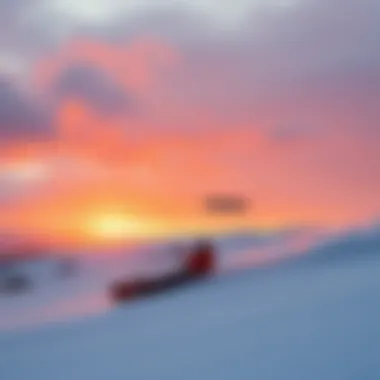
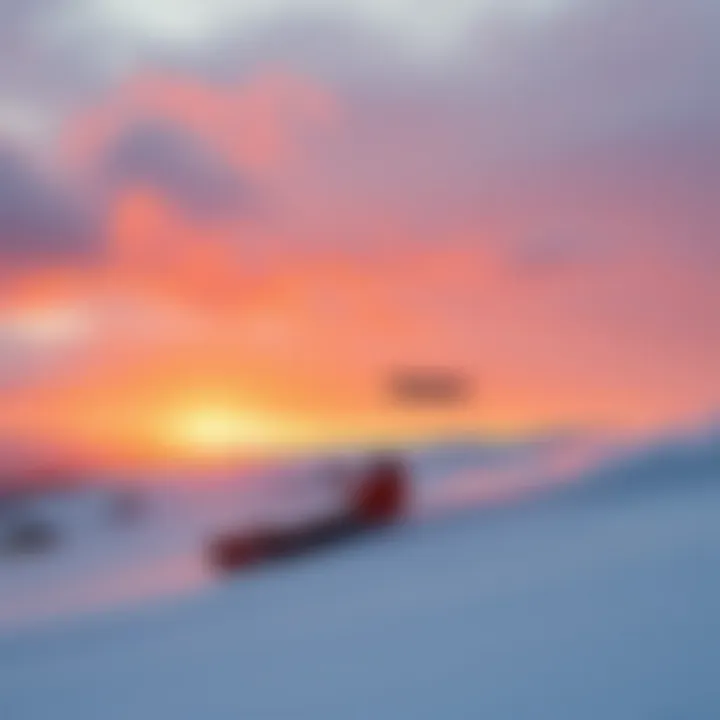
Furthermore, events often support local businesses, from gear suppliers to hospitality services, creating a vibrant economy around this thrilling sport.
Environmental Awareness
As snow kiting expands in popularity, so does the awareness of its environmental impact. Practitioners are increasingly mindful of their footprint, advocating for responsible practices to preserve Norway's pristine landscapes. This sport encourages a respect for nature since participants must rely on wind patterns and weather conditions that can rapidly change.
Many kiteboarders engage in conservation efforts, promoting sustainable practices such as:
- Respecting Wildlife: Staying clear of breeding areas and sensitive habitats.
- Leave No Trace Principles: Keeping the snowy terrain clean by taking all waste with them.
- Awareness Campaigns: Local organizations often run initiatives to educate kiteboarders about the ecological importance of the areas they frequent.
Practicing snow kiting comes bundled with a responsibility to protect the environments we revel in. Understanding our role ensures that future generations can experience the same joy.
In essence, the cultural significance of snow kiting in Norway is multifaceted. It nurtures a sense of community, encourages environmental stewardship, and reinforces a collective identity tied to the majestic landscapes and natural elements that define this beautiful country.
Snow Kiting and the Environment
Snow kiting, while exhilarating, is not merely about the thrill of gliding across snow-covered expanses. It's entwined with the environment in numerous ways. This section delves into the essence of this connection, highlighting both the responsibilities and impacts that come with this adventurous pursuit. The delicate balance between enjoying nature and preserving it weighs heavily on the minds of enthusiasts.
Responsible Practices
When snow kiting, the responsibility each participant holds is paramount. Not only does it encompass ensuring personal safety, but it extends to the greater ecosystem as well. Here are key practices to ensure that your snow kiting experience is both enjoyable and environmentally conscious:
- Stay on marked paths: Wandering off trails can lead to disturbing wildlife and causing erosion.
- Respect wildlife habitats: Particularly during breeding seasons, it’s wise to keep your distance from areas where animals are known to nest or feed.
- Leave no trace: Carrying out what you bring in, including trash and gear, upholds the pristine environment that draws kiting enthusiasts.
Implementing these practices not only protects nature but also enriches the experience of those who partake. An award-winning documentary "
"The Last Wild Spaces" emphasizes the importance of maintaining natural landscapes for future generations.
Impact of Weather Changes
Weather changes can significantly influence both the quality and safety of snow kiting. As we are witnessing global climate shifts, it is essential to pay attention to how these changes affect snowy landscapes. For example:
- Altered snow conditions: Warmer winters may result in slushy snow, impacting the enjoyment level for kiters.
- Reduced snow coverage: In certain regions, snow may not last as long, limiting the kiting season and pressing upon local economies that rely on winter sports.
- Extreme weather: Increased winds or unpredictable storms can pose dangers, amplifying the need for thorough safety protocols.
For kiteboarders, understanding these changing patterns isn’t just about adapting; it's about being proactive in seeking information and adjusting practices accordingly. Following local weather services like the Norwegian Meteorological Institute (met.no) can aid in this endeavor, providing insights necessary for safe planning.
In summary, while snow kiting offers unmatched thrills, it must be rooted in a deep respect for our environment. Balancing eagerness to ride the wind with responsible practices fosters not only our adventures today but also preserves nature's bounty for tomorrow.
Connecting with the Kiteboarding Community
Engaging with the kiteboarding community is more than just a social aspect of snow kiting; it's an essential ingredient for anyone looking to dive deeper into this exhilarating sport. By connecting with fellow enthusiasts, you open doors to shared experiences, essential tips, and a sense of belonging. Especially in a vast landscape like Norway, where snow kiting exploits the interaction between nature and skill, being a part of a network can enhance your understanding and appreciation.
Online Platforms and Resources
In today’s digital world, online platforms have revolutionized the way kiteboarders engage with one another. Websites and forums provide a treasure trove of valuable knowledge and insights that can help both beginners and seasoned riders alike. Here are a few key resources:
- Reddit: Subreddits focused on kiteboarding offer candid discussions, advice, and personal stories, allowing members to share triumphs and challenges in real time.
- Facebook Groups: Groups dedicated to Norwegian kiteboarding create spaces where members can discuss specific locations, gear recommendations, and even organize meetups.
- Local Forums: Websites specific to Norwegian outdoor sports often include dedicated sections for snow kiting. Such platforms can help you stay updated with the latest happenings, meet others with a passion for the sport, or even find a mentor.
"The real joy of snow kiting lies not just in the wind beneath your board, but the friendships forged along the way."
These online venues not only promote learning but also build connections that can transform solitary sessions into memorable group adventures.
Local Meetups and Competitions
Participating in local meetups and competitions can significantly enrich your snow kiting experience. These in-person events foster camaraderie among kiteboarders of all skill levels, allowing for the sharing of techniques and tips in a more hands-on environment.
Key benefits include:
- Skill Development: Competing encourages you to push your limits while observing how others tackle similar challenges. You might pick up on nuances in technique that you wouldn’t have considered otherwise.
- Networking Opportunities: Meeting local riders can lead to long-lasting friendships as well as connections that might benefit you in your snow kiting journey.
- Community Support: Events often have dedicated organizers and a plethora of resources, providing safety briefings and tips tailored to the specific locations being used.
In Norway, specific events are tailored to showcase the unique landscapes and winter conditions. Keep an eye on announcements from local kiteboarding shops or join groups on social media to stay informed about upcoming events!
Embracing the kiteboarding community offers you a chance to not just become a better rider but also a more integrated part of a vibrant culture that celebrates the freedom of snow kiting.
The Future of Snow Kiting in Norway
The world of snow kiting is on the brink of significant transformation, particularly in a country like Norway that boasts a rich outdoor culture. As the interest in adventure sports rises, understanding the future of snow kiting becomes crucial not just for participants but for the industry as a whole. This section explores the upcoming trends, innovations, and the potential obstacles that might arise as snow kiting advances within Norway's unique landscapes.
Trends and Innovations
In recent years, snow kiting has started to gain traction beyond just dedicated enthusiasts. New technological advancements and trends are continually shaping the way this sport is practiced. A few promising trends include:
- Enhanced Kite Design: Manufacturers are increasingly focusing on making kites that are lighter, more durable, and responsive. Innovations in materials and aerodynamics are paving the way for kites that can handle a range of wind conditions.
- Eco-Friendly Gear: With the growing awareness of environmental issues, several companies are launching eco-conscious products. There’s a noticeable shift towards sustainable materials for kites and associated gear, allowing enthusiasts to enjoy snow kiting while remaining mindful of their ecological footprint.
- Digital Integration: Mobile apps and wearable tech are reshaping the learning and experience of snow kiting. These tools help track performance, wind patterns, and even provide weather alerts. Such innovations mean that beginners can learn more effectively, while experienced riders can refine their skills.
- Community Growth: The growing interest in snow kiting is leading to more organized events, workshops, and competitions. This not only enhances community engagement but creates avenues for sharing knowledge and fostering a spirit of camaraderie among kiteboarders.
The future looks bright with these trends, as they make the sport more accessible and enjoyable for everyone involved.
Challenges Ahead
However, the exciting evolution of snow kiting in Norway does not come without its share of challenges. Several factors may impact the sport's future:
- Climate Change: As winter weather patterns shift, the availability of reliable snow and wind conditions may become erratic. This could affect the seasons, making some locations less viable for consistent snow kiting.
- Regulatory Hurdles: As the sport gains popularity, there may be increased pressure on local regulations and land use policies. There’s a delicate balance between promoting the sport and preserving natural spaces that kiteboarders rely on for their enjoyment.
- Safety Concerns: With a growing number of newcomers, ensuring safety while snow kiting becomes paramount. Increased participation can result in overcrowding on popular spots, which may lead to accidents if proper safety measures are not taken.
- Inclusivity: While the sport is gaining traction, efforts must be made to ensure snow kiting remains accessible to all, regardless of skill level or background. Programs aimed at underrepresented groups can foster a more inclusive community and ensure the sport thrives.
These challenges highlight the need for proactive approaches to secure a vibrant and safe future for snow kiting in Norway.
"The evolution of snow kiting in Norway reflects both excitement and responsibility, as we embrace the thrill while safeguarding our environments and communities."
For those eager to stay on top of trends and innovations, keeping an eye on brands like North Kiteboarding or following kiting events through Facebook could provide valuable insights.















